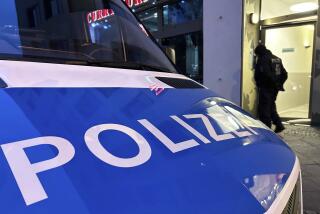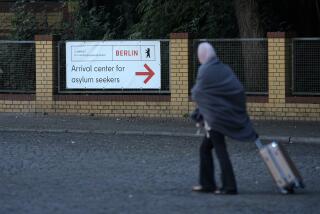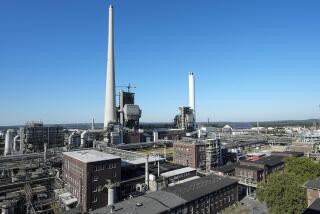No More Borders for 2 Germanys : Unification: With the merging of their social, economic and monetary systems, the final push toward full unity begins. A single Berlin re-emerges.
- Share via
EAST BERLIN — All borders disappeared between the two Germanys and a single Berlin re-emerged Sunday as the curtain rose on the final act of unification.
Hundreds of thousands of East Germans lined up at banks to withdraw their first fistfuls of deutschemarks after the state treaty merging the two nation’s economic, social and monetary systems went into effect at the stroke of midnight.
With it, the last guard stations and watchtowers along the once-formidable East German frontier were abandoned, leaving motorists, pedestrians and even bicyclists free to cross the inner-German borders unchecked for the first time in four decades.
“This is the decisive step on the path to unification of our fatherland, a big day in the history of the German nation,” West German Chancellor Helmut Kohl declared in a televised address Sunday night.
“Now unity becomes . . . reality in all important scopes of daily life for the German people,” Kohl said. “Germans can now once again come together unhindered. We rejoice over that; we Germans waited over 40 years for it to happen.”
East German Prime Minister Lothar de Maiziere posed grinning with a handful of Western hundred-mark bills for television cameras but struck a more somber note when he urged the nation not to embark on a “rash spending spree.”
“From now on, things will go upward,” he said in a televised address. “We have better chances than any other country in Eastern Europe. Let’s use them.”
The official West German news agency Deutsche Presse-Agentur trumpeted, “After 45 years of division, the inner-German border essentially stands no longer.”
Berlin, the prewar German capital, effectively became one city again Sunday, although it maintains two local governments.
The city district once bisected by the Berlin Wall began selling off old checkpoint signs that read, “Border Zone: Passage Not Allowed” for 75 D-marks (about $50), with some of the proceeds earmarked for a children’s home.
Streets blockaded by the division of Berlin about 29 years ago suddenly became East-West thoroughfares, and subways criss-crossed the city as they did long ago.
Two East Berlin “ghost stations” in the heart of the city were reopened after being bricked over by Communist authorities to prevent escapes on West Berlin trains rumbling through after the Berlin Wall went up in 1961.
“I can remember just seeing this station above ground,” said West Berliner Gabriella Vincents, 54, who took the subway to East Berlin to buy strawberries at an open-air stand. “It’s a strange feeling to get off now and be in East Germany. I don’t know how to describe it.”
Although shops were closed for the weekend, throngs of eager people crowded in front of display windows to gawk at the colorful Western products they will be able to buy this morning, and clerks worked overtime across the country to price the new wares.
“We never had so many products!” exclaimed Brigitte Beckert, a fiftyish clerk helping stock the shelves of a market in the East Berlin district of Treptow. “We have trouble keeping everything apart. It’s a very crazy feeling. I still get goose bumps.
“There are four kinds of mustard!”
Beckert surveyed a towering display of white and orange Tic-Tac mints. “It’s beautiful,” she said. “I couldn’t believe what I was seeing at first. We’re not used to such packaging.
“Simple and tasteless in cardboard--that’s how we always had it.”
The same awe was evident everywhere.
In Birkenwerder, a village of 6,000 located 10 miles outside Berlin, passers-by stopped to admire a rainbow heap of Western yarn in the window of a tiny textile shop that used to sell scraggly wool in a few drab shades.
In Potsdam, people gazed through a drugstore window at bottles of Western deodorant.
Even the trash testified to a new lifestyle for East Germans.
Coke cans and Snickers wrappers spilled out of city litter baskets, and East Berlin garbage collectors got a 33% pay raise after briefly striking to protest a lack of parity with West Berlin collectors. The East Berliners also argued that open borders and the influx of Western products had increased the amount of trash in East Berlin by 25%.
Banks opened especially for the currency exchange, which allows East German adults to swap savings of up to 4,000 marks (about $2,500) at a rate of one for one, with the rest bringing one deutschemark for every two ostmarks, the old currency of East Germany. Pensioners can cash in 6,000 marks ($3,750) at the one-for-one rate, and children are limited to 2,000 ($1,250).
“I saw one old man get a 500 D-mark bill and hold it up to his ear just to hear it crinkle,” said Rudiger Wrede, an East Berlin bank manager.
“Everybody’s been rearranging their money leading up to this,” said Ursula Sebold, manager of the state-run bank in Birkenwerder.
“There’s probably not a single East German left who doesn’t have a savings account now, from great-great-grandparents to newborns,” she said.
Seven hundred customers had flocked to the tiny bank by midday to get cash to tide them over for a week until new checks are ready, she said.
A policeman watched over the patient customers as they waited in line for an average of 40 minutes. Such security measures are alien to East Germany, the bank manager said.
“There was no need before,” Sebold said. “We never had bank robbers. What was the point? You couldn’t buy anything, and you couldn’t go anywhere.”
The banks have been assigned sister banks in West Germany, which sent 800 tellers, supervisors and other personnel to East Germany to help out with the transition.
New branches of West German banks also opened in East Germany, complete with balloons and lollypops for the kids.
More than 10,000 people from both East and West Berlin jammed East Berlin’s main Alexanderplatz to celebrate the union at midnight Sunday, and customers overwhelmed the lone bank that opened in the square at that hour. Two windows were cracked in the crush of people, but no serious injuries were reported.
Fireworks lit up the night, people tossed worthless East German coins into the air and traffic jammed the streets where East and West now not only meet but melt together.
“It’s all a new dimension for us,” said Potsdam bank manager Dieter Sachert. “It’s an extraordinarily beautiful feeling.”
Ursula Bauer was sitting in the bank Sunday afternoon waiting for her husband to withdraw some money. He came out clutching the crisp new bills as if they were World Cup tickets, catching his wife’s eye and flashing a victorious grin.
“We have to see what’s going to be possible,” she said.
NEXT STEP Some steps remain before unification is complete: First is agreement among the two Germanys and the four major victorious World War II Allies--the United States, Britain, France and the Soviet Union--on the military and strategic status of a united Germany. The strategic negotiations are scheduled to continue over the next two weeks with key meetings in London, Paris and Moscow. Finally, all-German elections are expected to take place in December, although no official date has been set.
More to Read
Sign up for Essential California
The most important California stories and recommendations in your inbox every morning.
You may occasionally receive promotional content from the Los Angeles Times.













